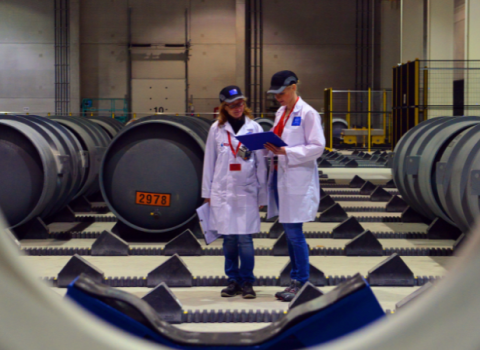Europe is a world leader in wave and tidal energy technologies, but bringing them to the market remains difficult. A new public private partnership, Clean Energy Transition, aims drive down costs and promote commercial deployment

Europe is a leading developer of ocean energy technology, but take up is lagging. To go beyond demonstrator projects, researchers are looking to standard hardware and market incentives.
“We are on the cusp of moving from technology push to market pull,” Henry Jeffrey, senior lecturer at Edinburgh University and chair of the European Energy Research Alliance’s (EERA) Ocean Energy programme, told Science|Business. “You can make [the technology] work to allow ocean energy to be an effective producer of electricity for European citizens. What is the challenge, is making that technology cost effective and competitive with other forms of low-carbon technology.”
EU waters have around 39 per cent of the global ocean energy capacity, and EU developed technology powers 70 per cent of current world capacity. “However, these are only the first steps in the creation of the ocean energy market,” said Davide Magagna, researcher at the EU’s Joint Research Council (JRC).
The 47 ocean energy projects funded by Horizon 2020 have helped to significantly advance both wave and tidal energy technology, according to a recent assessment by the JRC.
The most promising finding of the study, says Magagna, is that the cost of tidal energy technology, which captures energy generated by the rise and fall of ocean tides, is dropping faster than JRC predicted in 2015.
However, outstanding technical issues remain, including the efficiency of energy capture systems and the lifetime of devices, in what is a very hostile environment. Improvement of these two aspects could further reduce costs.
One of the weakest links is the power take off (PTO) hardware, which harnesses the power from the waves and transforms it into electricity.
Currently, all devices have bespoke PTO hardware, limiting how widely each design can be used and increasing production costs. A Horizon 2020 funded project, SEA-TITAN, is working on a cross-cutting, open source version of a PTO that can be used with any wave energy system.
The final product will be a prototype of a modular PTO that can be scaled up and down, and be used in different devices, says Francisco Garcia, CEO of Wedge Global, the Spanish marine energy company that is leading the project.
The PTO will be open source, meaning any interested company will be able to make its own version. Garcia hopes this will increase competition and shake up the market. “If there is no market, there is no competition and no money coming in,” he said.
However, standardising PTO design is not enough to secure Europe’s lead in ocean energy. Developers need the right policies in place to make the technology competitive enough for wider roll out.
“Many countries have strong innovation policies for the development and cost-reduction of demonstration devices. What is much less common is having a market pull mechanism for the deployment of devices,” Jeffrey said.
Most EU countries have mechanisms in place to encourage the adoption of renewable energy, but ocean energy is in its infancy and cannot compete with wind and solar power.
In the UK, for example, the government provides contracts of difference for renewables to de-risk investment. However, they set the same standards for different renewables, under which ocean energy cannot compete with other renewable sources that are already deployed at scale.
Without the right policies in place, Europe’s current lead in ocean energy technology is at risk. For example, most devices used in Canada are made in Europe, but the country has much better market pull mechanisms. If European countries do not adopt similar policies, there is a danger European developers will move to Canada, where it is easier to develop and sell their products, said Jeffrey.
Magagna agrees setting up market pull mechanisms remains one of the main challenges to overcome in deployment. In cases where the right policies are in place, the results have so far been positive, he notes.
Political will
By 2050, the ocean energy industry hopes to provide 10 per cent of the energy consumed in the EU, reducing carbon emissions and balancing out the current over-dependence on intermittent wind and solar energy.
It’s not possible to put a timescale on when Europe will have commercially viable options for harnessing ocean energy, but said Jeffrey, it is “in direct proportion to the political will that governments are going to continue funding it.”
Jeffrey is the chair of EERA’s Ocean Energy programme, a forum of 20-25 organisations in which members coordinate efforts, share knowledge and play an active role in drawing up plans for future Europe research and deployment. They determine topics for funding and then work with the commission to get them into relevant EU programmes.
In the last seven or eight years, Jeffrey says the ocean energy research landscape has changed significantly. Before, when the technology was at a lower readiness level, it was possible to fit many topics into one project. As the technology gets closer to the market, researchers cannot put everything in one basket and need more involvement from industry, which understands how to make the technology commercially viable.
Under the 2021 - 2027 Horizon Europe programme, the commission and industry will advance ocean energy research under the public private partnership, Clean Energy Transition. In the next seven years, the partnership sets out to bring ocean energy to commercial deployment, drive down costs, and maintain Europe’s leading position.
Another public private partnership, Blue Economy, could also make an indirect contribution in areas such as marine spatial planning and development of new materials and structures in the blue economy.
Magagna is hopeful Horizon Europe will continue to support the development of ocean energy at a bigger scale than Horizon 2020. However, he notes this will depend on the overall research budget, which was recently slashed by member states and is currently being contested in the parliament.
Garcia is content with the level of support for ocean energy coming from the commission. “On the other hand, I do not see a clear involvement of member states,” he said. ”One thing is Brussels, but there is a lack of coordination between the European Commission, the EU and the member states to make this happen.”





 A unique international forum for public research organisations and companies to connect their external engagement with strategic interests around their R&D system.
A unique international forum for public research organisations and companies to connect their external engagement with strategic interests around their R&D system.